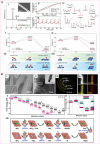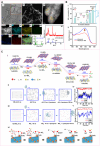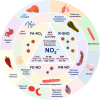Nitrite Reductases in Biomedicine: From Natural Enzymes to Artificial Mimics
- PMID: 40438154
- PMCID: PMC12117333
- DOI: 10.34133/research.0710
Nitrite Reductases in Biomedicine: From Natural Enzymes to Artificial Mimics
Abstract
Nitrite reductases (NiRs) are natural enzymes that facilitate the reduction of nitrite. They are essential for the microbial nitrogen cycle and play a vital role in regulating numerous physiological and pathological processes associated with nitric oxide (NO) in living organisms. By the merits of protein engineering, a variety of artificial NiR mimics have been developed. These include traditional artificial proteins, metal-azacycle complexes, and nanozymes such as metal, metal oxide/sulfide nanoparticles, metal-organic frameworks, bioinorganic nanohybrids, and advanced single-atom nanozymes. This development marks an important milestone in broadening the application of enzyme-like catalytic nitrite reduction across various fields, such as biomedicine, biosensing, food science, and environmental science. In this review, we first outline the different types of NiRs, along with their active center structures and catalytic mechanisms, drawing from recent research and discoveries. We then classify the reported NiR mimic materials, discussing their active center structures and enzyme-like catalytic mechanisms. Additionally, we explore the potential future applications and challenges facing NiR mimics in the field of biomedicine.
Copyright © 2025 Sai Zhu et al.
Conflict of interest statement
Competing interests: The authors declare that they have no competing interests.
Figures













Similar articles
-
Metal-Organic Framework Derived Nanozymes in Biomedicine.Acc Chem Res. 2020 Jul 21;53(7):1389-1400. doi: 10.1021/acs.accounts.0c00268. Epub 2020 Jun 29. Acc Chem Res. 2020. PMID: 32597637 Review.
-
Catalytically active nanomaterials: a promising candidate for artificial enzymes.Acc Chem Res. 2014 Apr 15;47(4):1097-105. doi: 10.1021/ar400250z. Epub 2014 Jan 17. Acc Chem Res. 2014. PMID: 24437921
-
Nanozymes: From New Concepts, Mechanisms, and Standards to Applications.Acc Chem Res. 2019 Aug 20;52(8):2190-2200. doi: 10.1021/acs.accounts.9b00140. Epub 2019 Jul 5. Acc Chem Res. 2019. PMID: 31276379
-
Emerging Nanomaterials as Versatile Nanozymes: A New Dimension in Biomedical Research.Top Curr Chem (Cham). 2024 Aug 14;382(3):28. doi: 10.1007/s41061-024-00473-w. Top Curr Chem (Cham). 2024. PMID: 39141170 Review.
-
Nanozymes-Hitting the Biosensing "Target".Sensors (Basel). 2021 Jul 31;21(15):5201. doi: 10.3390/s21155201. Sensors (Basel). 2021. PMID: 34372441 Free PMC article. Review.
References
-
- Li Y, Hodak M, Bernholc J. Enzymatic mechanism of copper-containing nitrite reductase. Biochemistry. 2015;54(5):1233–1242. - PubMed
-
- Kuypers MMM, Marchant HK, Kartal B. The microbial nitrogen-cycling network. Nat Rev Microbiol. 2018;16(5):263–276. - PubMed
-
- Fülöp V, Moir JWB, Ferguson SJ, Hajdu J. The anatomy of a bifunctional enzyme: Structural basis for reduction of oxygen to water and synthesis of nitric oxide by cytochrome cd1. Cell. 1995;81(3):369–377. - PubMed
-
- Einsle O, Messerschmidt A, Stach P, Bourenkov GP, Bartunik HD, Huber R, Kroneck PMH. Structure of cytochrome c nitrite reductase. Nature. 1999;400(6743):476–480. - PubMed
-
- Berks BC, Ferguson SJ, Moir JW, Richardson DJ. Enzymes and associated electron transport systems that catalyse the respiratory reduction of nitrogen oxides and oxyanions. Biochim Biophys Acta. 1995;1232(3):97–173. - PubMed
Publication types
LinkOut - more resources
Full Text Sources
Miscellaneous

